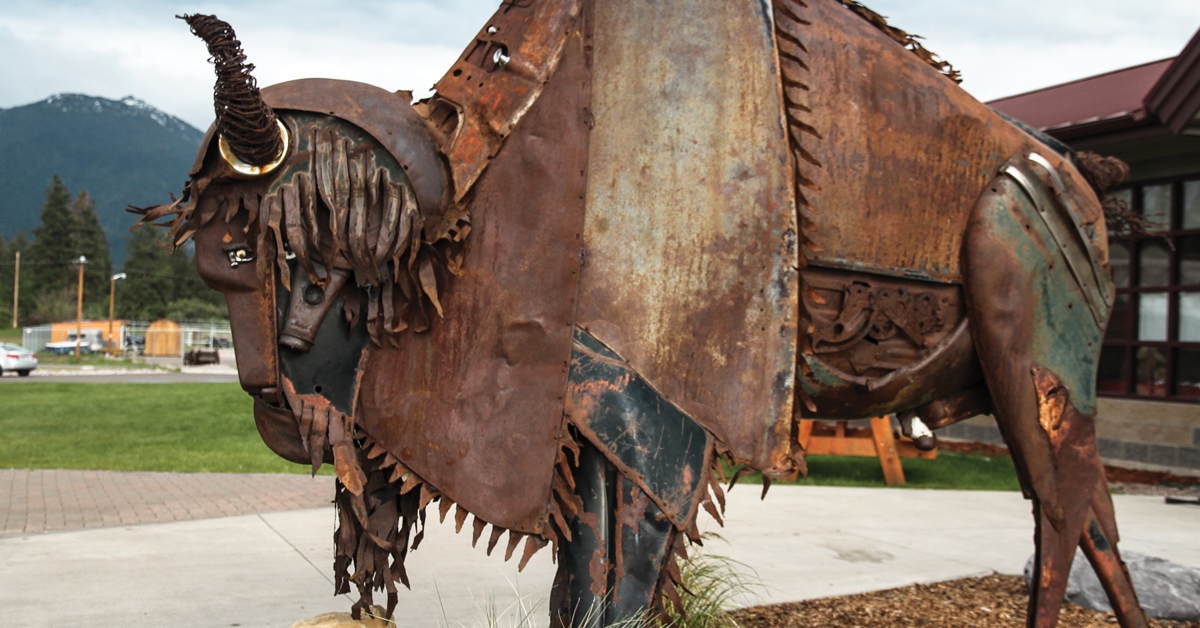The entire area we now call Montana was homeland for a number of Native American tribes for hundreds of years before the Lewis and Clark Expedition passed through on their westward trip in 1805 and on their way east the following year.
Early trappers soon followed, then homesteaders, and the world of Native Americans was forever changed.
The Flathead Reservation, like many reservations, is home to more than one tribe, the Confederated Salish and Kootenai Tribes. It may also be the most beautiful reservation in the country. It encompasses the southern portion of Flathead Lake, the largest natural lake west of the Mississippi.
The 20,000-acre National Bison Range is within its borders as is Ninepipe National Wildlife Refuge, a waterfowl management area. Both these areas are managed by the U.S. Fish and Wildlife Department but lie within the reservation boundaries.
Conservation Efforts
In 1982, the tribal council established a tribal wilderness, the only of its kind in the country, which encompasses 92,000 acres. Within this Mission Mountain Tribal Wilderness Area is a 10,000-acre grizzly bear conservation area.
Wilderness, grizzlies, bison, waterfowl—one readily sees the importance this reservation places on wildlife.
The complex of wetlands in and around Ninepipe NWR has provided the habitat for the reintroduction of trumpeter swans, a program that began in 1996. Now as many as 220 of these majestic birds use the reservation during the summer, and that number can swell to 300 when additional migrants winter there.
The wetlands are included in “Montana’s Wildlife Viewing Sites.”
Adding to these conservation efforts are 37 wildlife crossings along Highway 93, which runs through the reservation. The crossings allow wildlife of all kinds to safely cross from one side of the road to the other. Most are under-highway crossings, which serve as a national model for others to emulate.
In 2012, the Ninepipe NWR received a prestigious award from the National Wildlife Federation as the “Outstanding Conservation Organization” in the country.
Salish Language
Many tribes along the Pacific coast speak the Salish Language, which has many dialects, but the Confederated Salish and Pend d’Orielle here are the easternmost tribes to speak Salish.
The Kootenai language is very different, in fact it’s called a language isolate as it’s not related to any other language in the world. Both languages are being kept alive on the Flathead Reservation.
Ancestral Homeland
The reservation, at 1.3 million acres, is the seventh largest in the country and is actually larger than the state of Rhode Island. The ancestral homeland of more than 20 million acres was drastically reduced with the Hellgate Treaty of 1855. The current tribal population is over 8,000, roughly 6,000 of which live on or near the reservation.
Native Americans have a long history of serving the U.S. by enrolling in the various forms of military service in numerous wars and conflicts. The Salish/Kootenai people are no exception. One prominent example is Louis Charlo, the great grandson of Chief Charlo, who served as chief from 1870 until 1910.
Louis was a Marine and took part in the original flag raising at Iwo Jima. The famous photo of Marines raising the flag was actually the second flag raised, when a photographer was present.
Drastically, Louis was killed two weeks after the flag raising when he was shot while trying to rescue a fellow Marine. A stone etching of Louis stands near tribal headquarters in Pablo, Mont.
Education
Education is a priority for the reservation. Salish Kootenai College became accredited in 1984 and was the first tribal college in the northwest with that standing. Five years later, it became the third tribal college in the nation offering a registered nursing program.
Today the school offers five vocational programs and 19 associate degrees, plus four-year degrees in hydrology, psychology, forestry, life sciences, and in tribal historical preservation.
Athletics
The Flathead Reservation has also made its mark in the way of athletics.
The basketball teams at SKC have had phenomenal success in competition with other tribal schools. Since 2000 the men have won 10 national championships and the women have won six.
In boxing, tribal member Marvin Camel became boxing’s first cruiser-weight world champion in 1980. A book about him is titled Warrior in the Ring.
Tech Companies
Tribal business ventures are numerous, varied, and impressive. It was 1999 that S&K Technologies was formed and also S&K Electronics. In the succeeding 19 years, S&K Technologies alone has grown to five subsidiary companies with customers around the globe.
About two years ago, one of those companies, S&K Aerospace, won a $4.2 billion U.S. Air Force contract, working with 93 foreign military customers—the single largest contract to date.
Hydropower
About 18 months ago, the Confederated Tribes of the Flathead Reservation purchased Kerr Dam, now renamed Selis Ksanka Qlispe Dam, which is located below Flathead Lake on the Flathead River.
The Flathead tribe in the first in the nation to wholly own and operate a hydroelectric facility and now able to market over a million kilowatts of electricity.
Resorts
A third major operation, and likely of more interest to tourists, is the KwaTaqNuk Resort in Polson on the southern shore of Flathead Lake. It’s a beautiful facility with an outdoor patio overlooking the lake, 107 rooms plus several large rooms suitable for conventions, an indoor pool, restaurant, and gift shop—the list goes on.
The resort also has a casino, which the tribes manage in conjunction with the Gray Wolf Peak Casino north of Missoula.
Visitors might also enjoy visiting the People’s Place in Pablo. It’s listed as a cultural center but might also be called a museum. It allows visitors to learn more about tribal cultures surrounding the heritage of these tribes.
Quoting Rob McDonald, the tribes Communication Director, “It’s a place to laugh and swap stories and a place for people of all nationalities and tribal affiliations to visit.”










